News 2016
Picturing stories about the brain

November 10, 2016: Workshop combining natural scientific learning and creative drawing taking place at the Faculty of Engineering
The Rhythm of Attention: New study of principal investigator sheds light on effective communication between neuronal networks
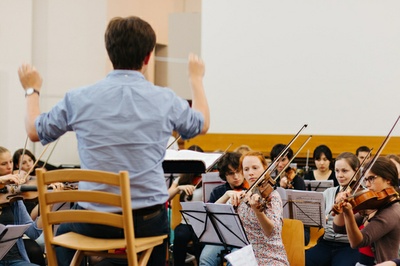
October 21, 2016: Strengthening some signalling pathways while weakening others is necessary for the brain to filter out information with behavioural relevance. When looking at the interaction of nerve cells, this process resembles the symphony of an orchestra.
Conversations with the Dalaï Lama in Strasbourg

September 16, 2016: What do Mindfulness, Meditation and Neuroscience have in common? Neuroscientists met with the Dalaï Lama to find out
Mastering the Game by Trial and Error: How machine learning could help to achieve targeted interactions with biological neuronal networks
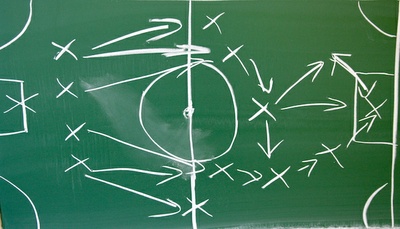
August 10, 2016: In football, one decisive element of the game is finding the right balance between offense and defense. While seeking to score as many goals as possible, it is just as important to intercept counterattacks of the opposing team. A similar trade-off can occur in the stimulation of neuronal networks where a stimulus interacts with the inherent activity of the networks and the efficacy of the stimulation depends on the right timing. But is there a way to automatically determine the optimal timing for each network?
Time to Say Goodbye! Junior research group leader Robert Schmidt to become Professor at Sheffield University

August 03, 2016: Dr. Robert Schmidt has been serving as head of the junior work group “Neural foundations of action selection, initiation and execution in the basal ganglia” at BrainLinks-BrainTools for three years. He has also been a member of the Bernstein Center Freiburg during this time. In September 2016, the neuroscientist will be moving on to a position as Lecturer at the University of Sheffield.
Migration of Dentate Granule Cells in Epilepsy
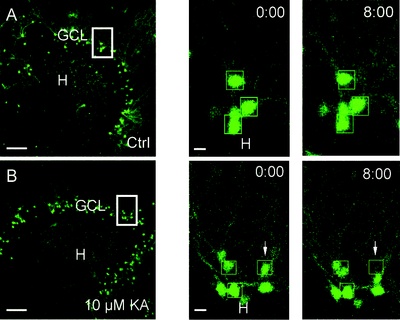
Microscopic imaging technique depicts movement of individual neurons
The Ethics of Personal Identity: Why the merging of man and machine requires a new discussion of what defines us as human individuals

Imagine being treated for Parkinson’s disease (PD), finding your personality altered permanently for the rest of your life. Walter Glannon, Professor of Neuroethics, reports a case in which a patient with PD showed symptoms such as chaotic behaviour and even megalomania after having undergone July 26, 2016: Deep Brain Stimulation, DBS. In this treatment, the electrodes of a stimulating device are inserted into the patient's brain in a neurosurgical procedure to treat the symptoms of the disease if traditional medication is no longer effective. Of course, adverse effects would have disappeared if the device was switched off. But this would also have meant that symptoms return, resulting in permanent disability.
Success at CNS 2016: Poster by Júlia Gallinaro receives honourable mention
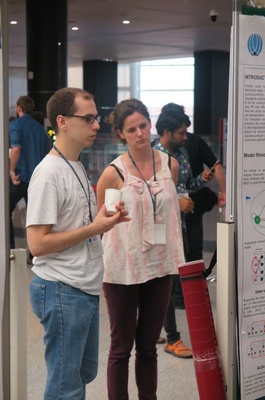
July 22, 2016: Júlia Gallinaro, PhD student at the Bernstein Center Freiburg, received an honourable mention at this year’s Computational Neuroscience Meeting (CNS). The conference, which changes its location every year, took place on 2 to 7 July 2016 in the South Korean island of Jeju. Out of 201 poster presentations altogether, Gallinaro’s poster about “Maturation of sensory networks through homeostatic structural plasticity” was among only five poster presentations to receive an honorable mention.
New Supercomputer for Neuroscience: NEMO cluster is now ready for use
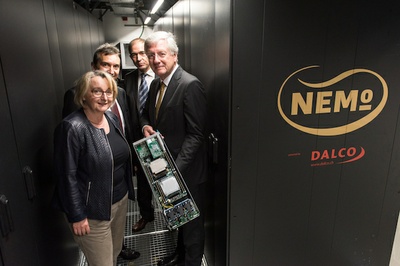
On the 14 July 2016, the Universities of Freiburg and Tübingen celebrated the inauguration of two new supercomputers. Their properties read like a list of superlatives: Both are listed among the 500 fastest computers in the world today – each combining the computing power of several thousand state-of-the-art home computers.
Identifying Brain Regions Automatically: Biologists develop a new method for analyzing brain images and demonstrate it with a study on fruit flies
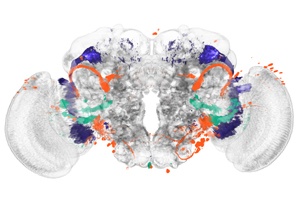
July 15, 2016: Using the example of the fruit fly, a team of biologists led by Prof. Dr. Andrew Straw has identified patterns in the genetic activity of brain cells and taken them as a basis for drawing conclusions about the structure of the brain. The research, published in Current Biology, was conducted at the University of Freiburg and at the Research Institute of Molecular Pathology (IMP) in Vienna, Austria.
Putting young scientists in the driver's seat: Freiburg researcher Ilka Diester to become FENS-Kavli Scholar
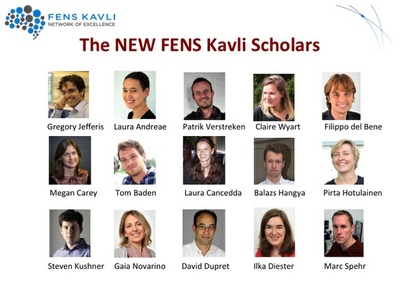
July 13, 2016: At this year's FENS Forum in Copenhagen, Prof. Dr. Ilka Diester , expert in the field of optophysiology and member of the Bernstein Center Freiburg and the cluster of excellence BrainLinks-BrainTools, was announced as FENS-Kavli Scholar by FENS and the Kavli Foundation.
Dancing Neurons: How the synaptic connections in a spiking neural network influence its dynamics
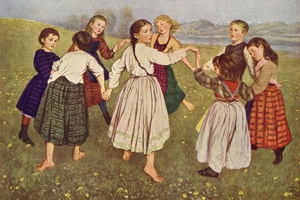
June 10, 2016: Understanding the dynamic processes that evolve in brain networks requires an exact knowledge of their network architecture. Regarding the circuit layout of their synaptic connections such networks could be organized in many different ways: There are “random” networks where neurons wire up with other neurons haphazardly, whereas in “assortative” networks there exist hub neurons with more connections than most others, and with a preference to hook up with other hubs. Comparing such network topologies, Stojan Jovanović and Prof. Dr. Stefan Rotter from the Bernstein Center Freiburg and the cluster of excellence BrainLinks-BrainTools showed in their recent computational study how specific forms of connectivity influence the strength of what is called “third-order correlations”.
Fascination Brain at Le Vaisseau in Strasbourg
On 24 May 2016 neuroscientists from the Bernstein Center Freiburg and BrainLinks visited the interactive science museum "Le Vaisseau"
Single-Neuron Properties and Network Dynamics: A new computational model shows when and how single neurons affect the activity of the entire network

May 25, 2016: Neurons in the brain are highly diverse. Depending on its individual properties, each neuron type is considered to be involved in one or multiple computations. For this reason, experimental neuroscientists have studied the genetic, anatomical, biochemical and electrophysiological features of neurons in great detail. However, it is not at all clear how and when these neuronal properties affect the activity of an entire network of neurons. In a new study, Ajith Sahasranamam, Dr. Ioannis Vlachos, Prof. Dr. Ad Aertsen and Prof. Dr. Arvind Kumar from the Bernstein Center Freiburg have now addressed this very issue.
How Neural Circuits Implement Natural Vision: Researchers have designed a new computational model to study how nerve cells in the visual cortex process natural stimuli

May 23, 2016: At any given moment, the neuronal circuits in the brain receive and process sensory information that permits us to perceive and interact with the environment. Yet it remains unclear how the visual brain processes natural stimuli. Together with an international team of researchers from the Centre Nationale de la Recherche Scientifique (CNRS) in Marseille, the CNRS in Gif-Sur-Yvette, and New York State University, neuroscientists Jens Kremkow and Ad Aertsen from the Bernstein Center Freiburg have developed a new computational model that simulates how neurons in the visual cortex process sensory stimuli. This model may help neuroscientists to better understand how neuronal networks in the visual system process natural stimuli. The study has now been published in the journal Frontiers in Neural Circuits.
Faulty Connection: Disturbed transmission of signals in the cerebrum promises new findings for epilepsy research
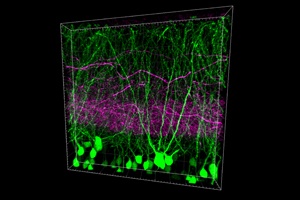
April 25, 2016: A research group at the Cluster of Excellence BrainLinks–BrainTools led by neurobiologist Prof. Dr. Carola Haas, also a member of Bernstein Center Freiburg, has discovered a mechanism that could be involved in the development of temporal lobe epilepsy. The team, which conducts most of its work at the Department of Neurosurgery of the Freiburg University Medical Center, explained in an article for the journal Cerebral Cortex how the modification of particular synapses and nerve cells boosts the transmission of signals from the temporal lobe, thus increasing the potential for seizures.
Closed-loop stimulation promises fewer side effects: How adaptive stimulation could make a significant difference for patients with neurological disorders such as Parkinson’s disease

February 01, 2016: Can closed-loop stimulation correct the aberrant brain dynamics associated with diseases like Parkinson’s without inducing negative side effects? This is one of the key questions Dr. Ioannis Vlachos and his colleagues Taskin Deniz, Ad Aertsen, and Arvind Kumar from the Bernstein Center Freiburg and the BrainLinks-BrainTools cluster of excellence addressed in a study now published in PLoS Computational Biology. Their new approach offers a significant step forward in the development of innovative methods in the treatment of Parkinson’s disease (PD).
"Should I stay or should I go?" – A newly discovered type of neuron could be the key to understanding why we initiate or inhibit movement
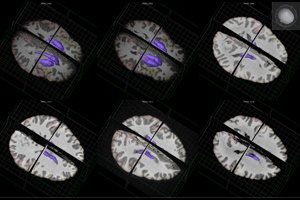
January 21, 2016: “Imagine that there is a race going on in your head. Only a few 10s of milliseconds will decide whether you will initiate a movement or don't move at all”, says Robert Schmidt, member of the Bernstein Center Freiburg and BrainLinks-BrainTools cluster of excellence. This stop/go race takes place between impulses from the nucleus subthalamus and the striatum – two regions in the basal ganglia. While the nucleus subthalamus emits a stop signal, a go signal is emitted by the striatum, and the signal that reaches the target region first also determines behavior.

